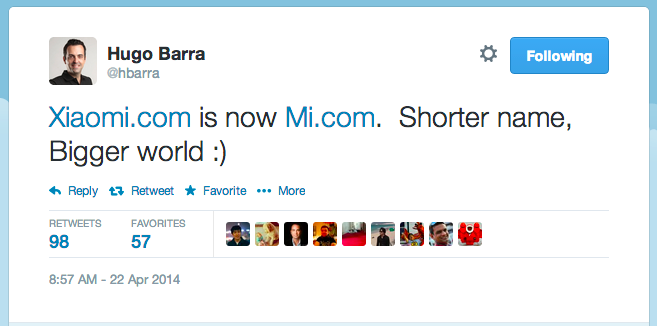Chinese Android devices startup Xiaomi has taken a pair of scissors to its domain name as it prepares to ramp up its global expansion plans — trimming those four tricky initial letters from the URL to create the shorter and altogether easier (for non-Chinese speakers) to pronounce, Mi.com.
Xiaomi translates literally as ‘little rice’. ‘Mi’ being the rice bit — so it’s fitting that the company should jettison the notion of ‘little’ as it seeks to ramp up its user-base by growing overseas. The ‘Mi’ in Xiaomi also functions as an acronym for ‘mobile Internet’ which offers a straightforward technology category for the company to associate itself with as it seeks to replicate its domestic success on an international stage.
The startup, which was founded in China in 2010 — releasing its first smartphone the year after (and going on to sell some 27 million handsets in two years), announced Singapore as its first international stepping stone outside China, Hong Kong and Taiwan this February. But it has far more ambitious global expansion plans — with more markets in South East Asia likely on the cards in the short term, and emerging markets generally in its sights.
Exactly how to pronounce ‘Xiaomi’ was how Hugo Barra, the company’s head of global (and former Android VP at Google), kicked off an interview with Re/code’s Kara Swisher last year after he’d announced his intention to swap offices in Mountain View for Beijing.
“Think of ‘show me,’ and then pronounce the first word as if it was ‘shower’,” was how Barra schooled Swisher then. Evidently the show me/shower nexus has proved a little more complex for non-Chinese speakers to grasp than he hoped.
Mi.com irons out the linguistic complexities, and means Barra won’t have to resort to any more outlandish comparisons/mental imagery to get the brand name across as it goes about his role promoting the Chinese upstart smartphone maker abroad.

His presence in the company overseeing its global expansion plans is a strong sign that his native Brazil is one of the markets on Xiaomi’s future roadmap. But the company has been wary of revealing too much detail about where exactly it intends to take its Android devices next. One source previously told TechCrunch Xiaomi is assessing European markets such as Russia but said any launches in that region are some two years out at this point.
Xiaomi has been spectacularly successful in its native China. Back in March, it said it shipped 11 million smartphones in the first quarter of this year, with a target of 60 million by year’s end. Earlier this month a 12-hour ‘fan festival’ flash sale enabled it to sell 1.3 million phones — and pull in 1.5 billion yuan (~$240M) in revenue, helped along by sales of hundreds of thousands of Mi Bunny plush toys.
It’s going to want to be able to replicate the success it’s had in its home region, of building hype and sales via social media, as it expands further afield — building out overseas teams to support local community-building efforts. And streamlining its branding to appeal across multiple cultures is one small step on that road.
